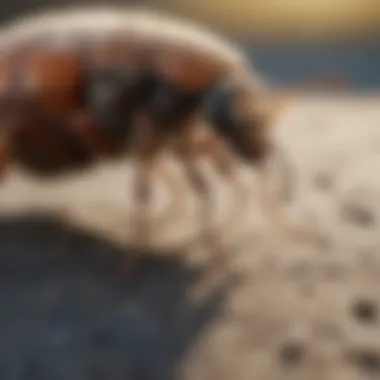Mastering Flea Bombs: A Comprehensive Treatment Guide


Intro
Flea infestations can be a challenging problem for homeowners. Understanding how to effectively deal with these pests is vital. This guide aims to shine a light on one of the more aggressive methods—flea bombs. Knowing the function and application of flea bombs can help you regain control over your living space. Furthermore, addressing safety precautions ensures that the process is not only effective but also secure for your family, pets, and the environment.
Understanding Pests
Definition of Pests
Pests are organisms that can cause harm to human health, property, and the environment. Fleas are small, wingless insects that feed on the blood of their hosts, which can include cats, dogs, and even humans. The bites of fleas can lead to irritation and allergic reactions. Their rapid reproduction rate makes them particularly problematic in a home setting.
Importance of Pest Identification
Correct identification of the pest is crucial for effective control. Fleas are often confused with other insects, which can lead to misinformed treatment options. Homeowners should be vigilant and identify the signs of a flea problem, including bites and visible adult fleas or flea dirt. Understanding the lifecycle of fleas helps in determining the right treatment method, such as when and how to use flea bombs.
Prevention Techniques
Home and Garden Preventative Measures
To avoid infestations, homeowners should implement several preventive measures:
- Regular vacuuming of carpets and upholstery
- Washing pet bedding in hot water
- Keeping grass trimmed and the yard tidy to eliminate hiding spots
These actions can significantly reduce the likelihood of fleas taking hold in your home.
Seasonal Prevention Tips
Flea activity often accelerates during warmer months. Homeowners should be proactive during spring and summer by applying flea treatments and checking pets regularly. Having a pest control plan in place for seasonal changes can save trouble later.
Eco-Friendly Pest Control Solutions
Overview of Sustainable Practices
Incorporating eco-friendly measures into pest control can be an effective way to keep your home safe. Solutions like diatomaceous earth or essential oils can repel fleas without harsh chemicals. Consider these as part of your overall strategy to manage pests sustainably.
Natural Remedies and Their Effectiveness
Natural remedies vary in effectiveness depending on the severity of the infestation. Some effective options include:
- Apple cider vinegar sprayed on pets and around the home
- Salt used as a dehydrating agent on carpets and furniture
- Herbal essences like rosemary or citrus that can repel fleas
However, these methods should not replace comprehensive measures where infestations are severe.
Finale
Understanding flea bombs and their application is an essential part of tackling infestations. This guide provides the relevant information to make informed decisions about pest control. Being knowledgeable on prevention techniques and eco-friendly solutions contributes to a broader strategy against pests, enhancing the effectiveness of flea bombs when they are necessarily deployed.
Understanding Flea Bombs
Flea bombs represent a critical solution in the management of flea infestations within households. Understanding their functionality, composition, and various types can significantly empower homeowners, especially those who prefer to tackle pest issues independently. Fleas can reproduce quickly and can become a more serious, ongoing issue if not handled promptly. Thus, familiarizing oneself with flea bombs is not merely about knowing a product, but understanding an essential tool in pest control. This section will delineate the core aspects of flea bombs, and their importance in addressing infestations effectively.
Definition and Function
A flea bomb, often referred to as a flea fogger, emits a pesticide mist that penetrates areas infested by fleas. The primary function is to eliminate adult fleas and their eggs, providing immediate relief as well as a preventive measure against future outbreaks. They work by releasing an aerosolized fog that covers a wider area than typical sprays, making it easier to reach hidden corners and crevices where fleas tend to hide. This action helps disrupt the flea lifecycle, which is crucial for long-term infestation management.
Chemical Components


The effectiveness of flea bombs largely lies in their chemical composition. Common components include insect growth regulators (IGRs) that disrupt the development of juvenile fleas and traditional pyrethroids that target adult fleas directly. Pyrethrin, derived from chrysanthemum flowers, acts as a natural insecticide. Understanding these components is essential, as some individuals may have sensitivities to certain chemicals. Conscientious selection can minimize health risks while enhancing the overall efficacy of the treatment.
Types of Flea Bombs
Flea bombs vary in formulation and delivery method. The most common types include:
- Standard Foggers: Deliver a fog that settles throughout a room, ideal for large and heavily infested areas.
- IGR-Focused Bombs: These specifically target the growth stages of fleas, making them suitable for preventative measures.
- Natural Flea Bombs: Formulated with plant-based pesticides, catering to consumers looking for a safer alternative.
Understanding the differences among these types can aid homeowners in selecting the appropriate flea bomb tailored to their specific infestation scenario.
Preparing the Room for Treatment
When using flea bombs, preparation is essential for successful flea elimination. Properly preparing the room can enhance the effectiveness of the treatment and ensure the safety of all living beings in the household. Ignoring preparation may lead to incomplete treatment or unnecessary risks for family members and pets. In this section, we will cover the groundwork necessary to optimize flea bomb usage, focusing on clearing the area, protecting personal belongings, and identifying flea infestation zones.
Clearing the Area
Before deploying a flea bomb, it is critical to clear the area of all people and pets. Flea bombs release insecticides that can pose health risks if inhaled or ingested. Removing everyone, including pets, from the treatment zone minimizes exposure to these chemicals. Ensure that plants and food items are also moved out.
- Evacuate all occupants: This includes both humans and animals.
- Ventilate: Open windows and doors to increase air circulation before starting the process.
- Check for sensitive areas: Areas with aquariums or delicate items should be especially considered.
By taking the time to clear the space, you can create a safer environment for the treatment and enhance the effectiveness of the flea bomb.
Protecting Personal Belongings
In addition to clearing the room, protecting personal belongings from potential contamination is vital. Flea bombs can leave residues that are harmful to objects in the vicinity.
- Cover furniture: Use sheets or plastic covers to shield sofas, chairs, and tables.
- Secure electronics: Ensure that electronic devices are covered or moved out of the treatment area.
- Store valuables: Keep jewelry, important documents, and other personal items in a safe location.
Protecting belongings not only safeguards your possessions but also ensures that after the treatment, there are no lingering chemicals that can affect health.
Identifying Flea Infestation Zones
Understanding where fleas are concentrated plays a crucial role in ensuring effective treatment. Infestation zones can be identified for targeted application of flea bombs.
- Look for signs: Check for flea dirt, which appears as small black specks, on carpets, bedding, and furniture.
- Use traps: Consider placing sticky traps around suspected areas to gauge flea activity.
- Inspect resting areas: Common zones for fleas include where pets sleep, often between floorboards and in upholstered furniture too.
Identifying these areas means that flea bombs can be used more efficiently, allowing you to focus on treatment where it is needed most.
Application of Flea Bombs
The application of flea bombs is crucial in effectively addressing severe flea infestations within the home. Understanding the proper usage of these products contributes significantly to their effectiveness. When deployed correctly, flea bombs can eliminate not only adult fleas but also their eggs and larvae, which are often the most challenging stages of the flea lifecycle.
Yet, applying flea bombs requires careful consideration. It’s essential to follow instructions rigorously and take necessary precautions to ensure safety for inhabitants, including pets and children. Effectively using flea bombs can create a pest-free environment, enhancing overall household comfort and health.
Step-by-Step Instructions
- First, identify the areas heavily infested with fleas. Fleas often reside in carpets, upholstery, and cracks in floors.
- Clear the room of furniture, toys, and other personal items. This ensures the flea bomb can reach the maximum surface area.
- Shake the flea bomb canister gently to mix its ingredients.
- Place the canister on the floor, ideally on a piece of cardboard or paper, to catch any drips.
- Activate the flea bomb according to the manufacturer’s guidelines. This often involves pressing down on the top until it clicks.
- Exit the room immediately, ensuring all doors and windows are closed to keep the treatment contained.
- Allow the canister to disperse the insecticide for the recommended time, usually a minimum of two hours.
- After the duration has passed, ventilate the area thoroughly before returning. Leave windows and doors open for increased airflow.
Proper execution of these steps is vital in maintaining household safety and ensuring effective flea control.
Dos and Don'ts of Usage
Dos:
- Do read the instructions carefully before use.
- Do wear protective gear such as gloves and masks during application.
- Do ensure pets and children are kept away from treated areas.
- Do ventilate the area after treatment.


Don'ts:
- Don’t use multiple flea bombs in the same space without sufficient drying time.
- Don’t apply in areas with inadequate ventilation.
- Don’t skip pre-treatment preparations, as this can hinder effectiveness.
- Don’t expose food items or utensils to the treatment area.
Timing the Treatment
Timing the application of flea bombs can influence the success of infestation control. Ideally, flea bombs should be deployed in the evening when chances of people or pets re-entering the treated area are lower. Additionally, if known flea activity increases during warmer months, early preventive treatments may be beneficial. Regularly monitoring the infestation before and after treatment will help in adjusting the timing of subsequent treatments if necessary.
Health and Safety Precautions
The topic of health and safety precautions is crucial when using flea bombs to manage pest infestations. Flea bombs contain potent chemicals that, while effective in eradicating fleas, can pose serious risks to human health and the environment if not used correctly. Understanding these risks ensures users take adequate measures to protect themselves, their pets, and their living spaces.
Understanding Health Risks
The chemicals in flea bombs, often classified as insecticides, can be harmful to humans and animals. Common ingredients might include pyrethroids and organophosphates. Exposure can result in symptoms ranging from mild irritation to severe health issues. Effectively, short-term exposure may lead to headaches, dizziness, or respiratory distress, while long-term exposure might escalate to more serious conditions. It is important to adhere to recommended guidelines and only use flea bombs in well-defined circumstances to minimize health risks for all household members.
Protective Gear Recommendations
When preparing to use a flea bomb, wearing appropriate protective gear cannot be understated. This gear serves as a frontline defense against chemical exposure. Recommended items include:
- Facemask: Helps to prevent inhalation of fumes.
- Gloves: Protects hands from skin contact.
- Safety Goggles: Guards against splashes.
- Long-Sleeved Clothing: Additional barrier against skin irritation.
These items are vital, especially in enclosed spaces where chemical concentrations may be higher. Adherence to using protective gear distinguishes safe practices from negligence during flea treatment processes.
Ventilation Needs
Proper ventilation is an essential component of safely administering flea bombs. Adequate airflow helps dilute harmful chemicals in the treated environment, reducing the risk of inhalation. Before starting the fumigation process, open windows and doors to facilitate fresh air circulation. Consider placing fans strategically to enhance airflow. After application, it is advisable to leave the treated area sealed for the recommended duration. Once this time period concludes, allow sufficient time for the space to air out before re-entering. This step is critical in ensuring that any lingering chemicals are dissipated, creating a safer environment for you and your pets.
Taking the necessary health and safety precautions while using flea bombs ensures effective pest control without compromising the well-being of your household.
Following these guidelines connected with health and safety can significantly mitigate risks associated with flea bomb usage. This makes the process not only effective in eliminating fleas but also safe and manageable for all involved.
Post-Treatment Procedures
Post-treatment procedures are critical in ensuring the effectiveness of flea bombs. After using a flea bomb, the way you manage the treated space can greatly influence both safety and pest control efficacy. Following these procedures attentively can help confirm the successful elimination of fleas and mitigate potential hazards.
Re-entering the Treated Area
After the treatment is complete, one must approach re-entering the space with caution. It is advisable to wait at least several hours, or as recommended by the product label, before entering the area again. This waiting period allows toxic chemicals enough time to dissipate, reducing health risks. Remember to check the ventilation in the area. Open windows and doors for several minutes to air out the room.
Upon re-entry, look for any residual odors or signs of flea activity. Use clear and direct communication with others in the household to ensure everyone understands the safety protocols necessary during this transition.
Evaluating Effectiveness
Evaluating the effectiveness of the flea bomb treatment requires a systematic approach. After a week has passed, monitor the area closely to see if any fleas remain. It may be beneficial to use a flea comb on pets and check areas where fleas often hide, like carpets and upholstery. Consider setting flea traps to assess activity levels.
If flea activity persists, it might be necessary to repeat the treatment. Note any changes in behavior of pets or people in the home. Document these findings for future reference, and evaluate why the initial treatment may not have worked as expected.
Follow-Up Actions
Immediate follow-up actions are essential after using flea bombs. First, laundry washing is recommended to eliminate any eggs that may have escaped treatment. Be sure to wash bedding and pet items in hot water. Second, vacuum carpets and furniture regularly to remove dead fleas and their eggs. Dispose of the vacuum bag immediately to prevent any living fleas from re-entering the house.
Further, consider enhancing other pest control measures alongside flea bombs, such as using flea preventive treatments for pets or consulting with a pest control professional. Maintaining cleanliness in the home can also deter future infestations.
In summary, engaging in proper post-treatment procedures enhances the efficacy of flea bombs while safeguarding the home and health of its inhabitants. Active management and ongoing evaluation can minimize the risk of future infestations.


Common Misconceptions About Flea Bombs
Understanding common misconceptions about flea bombs is essential for homeowners dealing with flea infestations. Many individuals inadvertently propagate myths that can lead to ineffective treatments or unsafe practices. Addressing these misconceptions not only informs better pest management strategies but also enhances the safety and effectiveness of using flea bombs in their homes.
Efficacy in Severe Infestations
One significant misconception is that flea bombs can single-handedly eliminate severe infestations. While flea bombs do release insecticides designed to kill adult fleas and some larvae, they may not be effective on all life stages. Fleas reproduce quickly, and a single treatment may not address every developmental stage, particularly eggs and pupae. It often requires multiple treatments or combining methods—such as vacuuming and using sprays—to achieve complete eradication. Homeowners must also consider the specific type of flea bomb. Some products may be formulated specifically for severe cases, so reading the labels and understanding the advertised effectiveness is important.
Safety for Pets and Children
Another common concern is that flea bombs are not safe for pets and children. While flea bombs can be hazardous if not used correctly, precautions minimize the risks. Many products require vacating the area during treatment and ensuring thorough ventilation afterward. Following the manufacturer's instructions on safety can allow families and their pets to return once it is safe. Additionally, some manufacturers produce pet-safe options. It is often necessary to check the ingredient list and warnings before making a selection. This vigilance is part of a responsible approach to flea bomb usage.
Environmental Impact
There exists a prevailing concern regarding the environmental impact of using flea bombs. Some people believe that flea bombs harm the ecosystem. While flea control is essential, it is crucial to consider the chemicals being used. Many modern flea bomb products are designed with a focus on reducing environmental impact while still being effective. Homeowners should research eco-friendly options and compare chemical ingredients that minimize risks to the environment. Taking steps to understand these aspects enables better decision-making and promotes more sustainable pest control methods.
Keeping informed about flea bomb misconceptions empowers homeowners. This knowledge leads to safer treatments and more successful pest management solutions.
By addressing these misconceptions, one can better navigate the complexities of flea bomb usage and drive effective strategies for combating infestations. An informed approach eliminates confusion and promotes a more confident application of pest control methods.
Alternative Pest Control Methods
In the realm of managing flea infestations, alternative pest control methods hold significant value. While flea bombs serve a crucial purpose in eradicating pests, they may not be the only solution suitable for every situation. Understanding these alternatives can empower homeowners to make informed decisions. This section discusses the main alternatives to flea bombs, weighing their benefits and key considerations.
Eco-Friendly Options
The growing awareness of environmental concerns drives many to seek eco-friendly pest control options. These methods often use natural ingredients, which are less harmful to humans, pets, and the environment. Products like diatomaceous earth and essential oils, such as lavender and peppermint, can deter fleas effectively.
When employing eco-friendly options, it's essential to consider the specific needs of your household. For instance, while essential oils can effectively repel fleas, they may also cause allergic reactions in some individuals. Therefore, conducting a patch test before full application is wise.
Professional Pest Control Services
Engaging professional pest control services can be an efficient route to tackle severe flea infestations. These specialists have access to advanced tools and methods not accessible to the average homeowner. They can assess the situation comprehensively and customize treatments based on the degree of infestation.
It is imperative to research reputable service providers. Look for companies with positive reviews and clear certification. Professional services often provide a follow-up treatment plan, which may help ensure that fleas do not re-infest the space. Costs can vary, therefore budget considerations should be part of the decision-making process.
Preventative Measures
Prevention remains a vital aspect of flea management. Implementing proactive measures can save extensive time and money in the long run. First, frequent cleaning of carpets, upholstery, and pet bedding can significantly reduce flea populations. Using a vacuum regularly can remove eggs and larvae before they mature.
Additionally, regular grooming and bathing of pets can play a crucial role in prevention. Utilizing preventative treatments, such as topical flea medications or flea collars, can add an extra layer of protection. Combining these approaches creates a multi-faceted defense strategy against infestations.
"An ounce of prevention is worth a pound of cure." - Benjamin Franklin
In summary, exploring alternative pest control methods not only offers different options but can also lead to effective solutions for flea infestations. Each method comes with its own set of advantages and challenges, emphasizing the importance of choosing a strategy that aligns with your particular context and values.
Epilogue
In concluding this guide on flea bombs, it is vital to reinforce the importance of understanding their usage and effectiveness. The informed application of flea bombs can significantly mitigate flea infestations while ensuring the safety of household members. Homeowners must recognize that efficient pest control requires not only a robust product but also adherence to safety measures and proper techniques. Thus, diving deep into the intricacies of application and post-treatment procedures adds immense value for those facing flea issues.
Summing Up Key Points
- Functionality: Flea bombs work by releasing insecticides that target fleas at various life stages. Understanding their chemical composition is crucial for achieving the desired outcome.
- Preparation: Before using flea bombs, clearing the area and protecting belongings is essential to maximize effectiveness and minimize risk.
- Application Method: Proper application techniques can greatly influence the efficacy of the treatment. Following detailed instructions ensures optimal results.
- Health Considerations: Ensuring safety through protective gear and ventilation post-treatment is necessary to safeguard health, especially for children and pets.
- Common Misconceptions: Addressing misconceptions about flea bomb efficacy and safety can encourage informed decisions among homeowners.
"Knowledge is the first step toward effective pest management."
Final Thoughts on Flea Bomb Usage
Flea bombs can be an effective weapon in the fight against infestations when used correctly. However, it is essential to approach this method with responsibility and awareness. Homeowner awareness about the implications of chemical exposure plays an integral role in overall safety. Regular maintenance and preventive measures should be part of a comprehensive strategy against flea infestations. Using flea bombs wisely, combined with alternative pest control methods, can lead to a flea-free environment.
In summary, treating flea infestations requires a comprehensive understanding of treatment options, including flea bombs, to ensure both effectiveness and safety.



